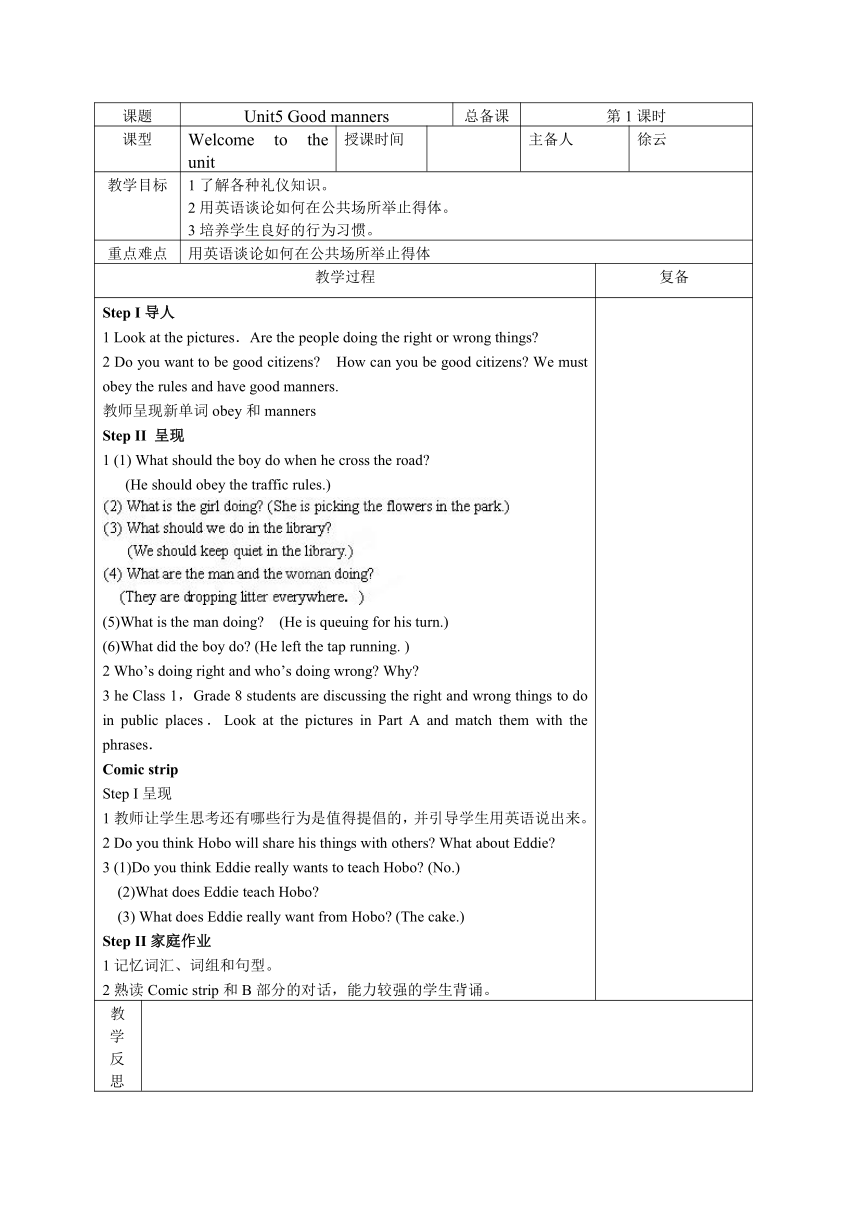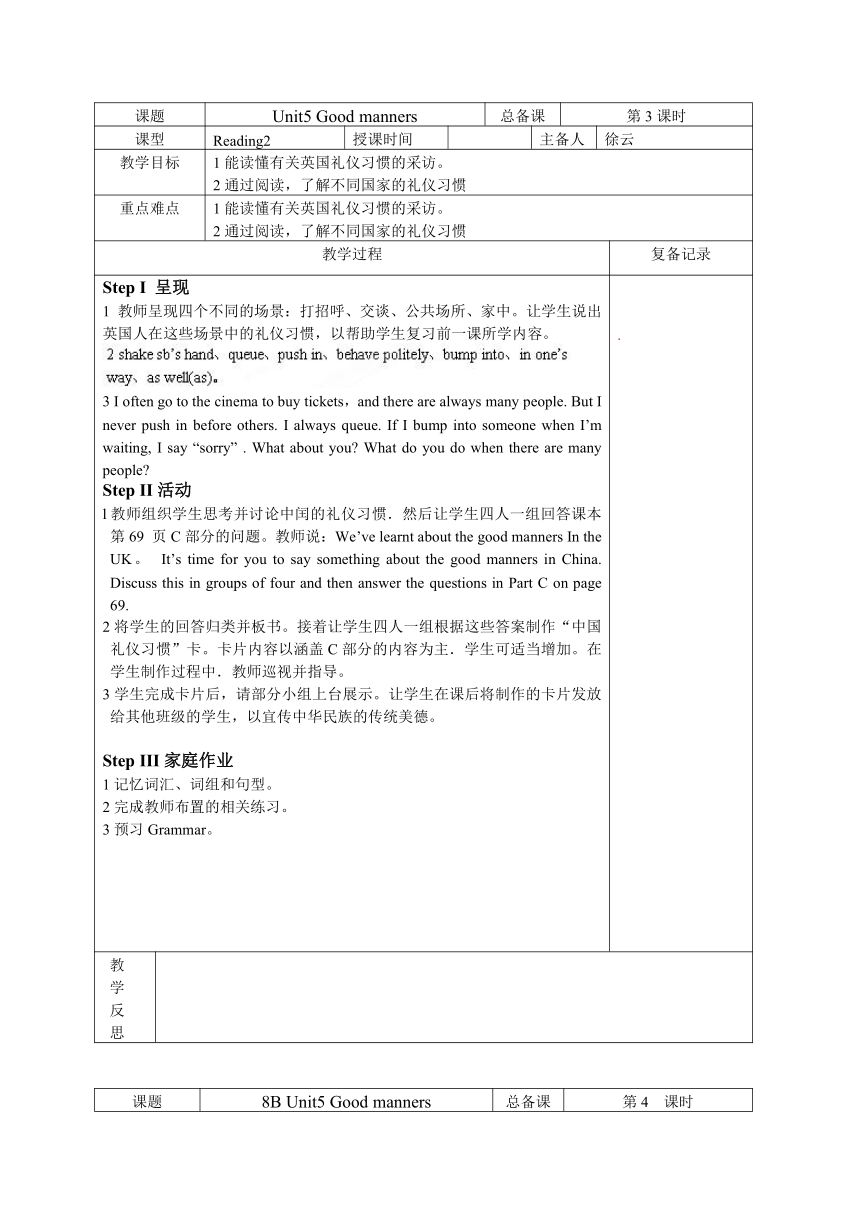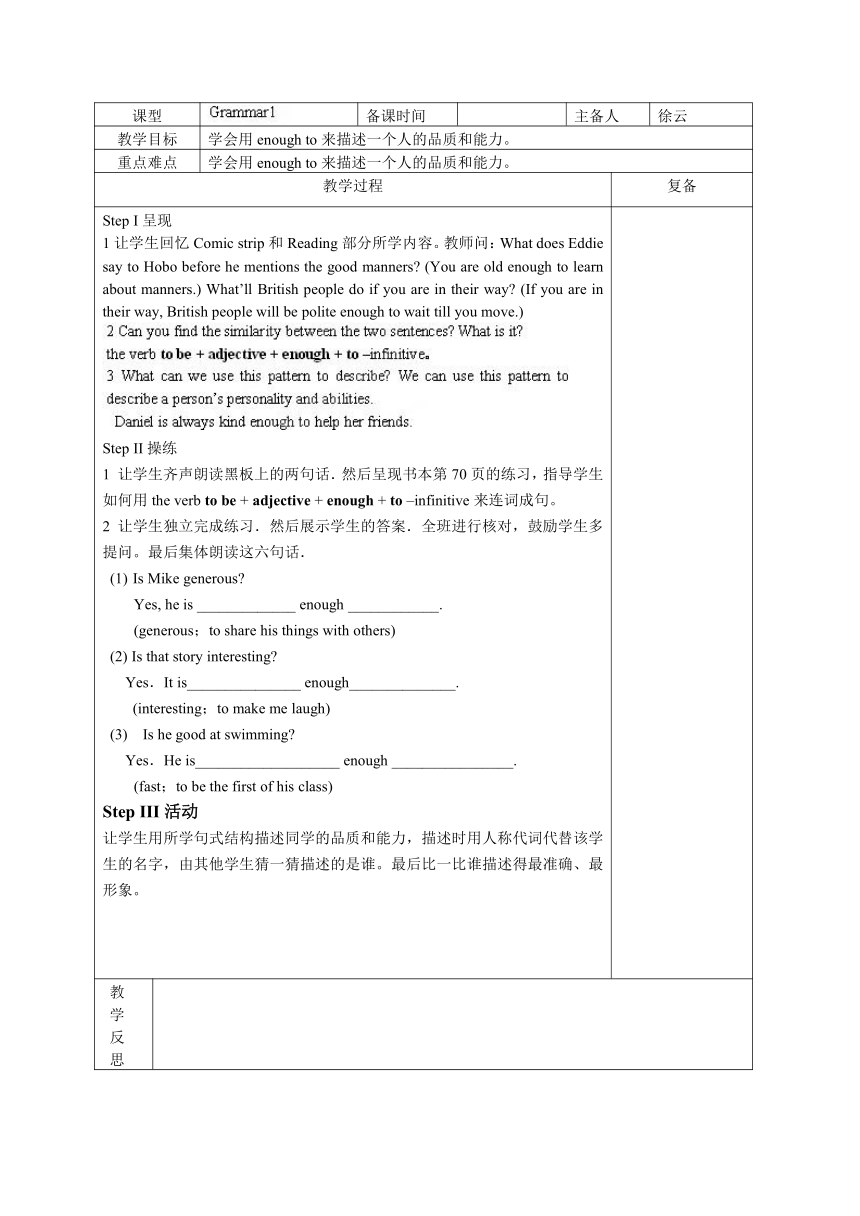牛津译林版八年级下Unit 5 Good manners单元表格式教案
文档属性
| 名称 | 牛津译林版八年级下Unit 5 Good manners单元表格式教案 |  | |
| 格式 | zip | ||
| 文件大小 | 84.7KB | ||
| 资源类型 | 教案 | ||
| 版本资源 | 牛津译林版 | ||
| 科目 | 英语 | ||
| 更新时间 | 2016-06-06 15:45:19 | ||
图片预览





文档简介
课题 Unit5 Good manners 总备课 第1课时
课型 Welcome to the unit 授课时间 主备人 徐云
教学目标 1了解各种礼仪知识。2用英语谈论如何在公共场所举止得体。3培养学生良好的行为习惯。
重点难点 用英语谈论如何在公共场所举止得体
教学过程 复备
Step I导人1 Look at the pictures.Are the people doing the right or wrong things 2 Do you want to be good citizens How can you be good citizens We must obey the rules and have good manners.教师呈现新单词obey和mannersStep II 呈现1 (1) What should the boy do when he cross the road (He should obey the traffic rules.) (5)What is the man doing (He is queuing for his turn.)(6)What did the boy do (He left the tap running. ) 2 Who’s doing right and who’s doing wrong Why 3 he Class 1,Grade 8 students are discussing the right and wrong things to do in public places.Look at the pictures in Part A and match them with the phrases.Comic stripStep I呈现1教师让学生思考还有哪些行为是值得提倡的,并引导学生用英语说出来。2 Do you think Hobo will share his things with others What about Eddie 3 (1)Do you think Eddie really wants to teach Hobo (No.) (2)What does Eddie teach Hobo (3) What does Eddie really want from Hobo (The cake.)Step II家庭作业1记忆词汇、词组和句型。2熟读Comic strip和B部分的对话,能力较强的学生背诵。
教学反思
课题 Unit5 Good manners 总备课 第2课时
课型 Reading1 授课时间 主备人 徐云
教学目标 1能读懂有关英国礼仪习惯的采访。2通过阅读,了解不同国家的礼仪习惯。
重点难点 1能读懂有关英国礼仪习惯的采访。2通过阅读,了解不同国家的礼仪习惯。
教学过程 复备
Step I呈现l Can you tell me what we should and shouldn’t do in these public places 2 British people shake hands when they meet for the first time. shake sb’s hand。StepII阅读l让学生快速阅读文章.并回答两个问题:(1)What is the conversation about (Good manners in the UK.)(2)Who is Daniel talking to (Jenny.)2 Part 1 (1ines 1—6)(1) What is the proper way to greet people in the UK (British people say ‘hello’ or “ nice to meet you” and shake the other person’s hand when they meet for the first time. )(2) Who do they greet With a kiss (They only greet relatives or close friends with a kiss.)Part 2 (1ines 7—17)(1) How do British people start a conversation (They talk about the weather, holidays, music, books, etc.)(2) Do they talk about age (No, they do not. )(3) How do they behave in public (They behave politely in public. )Part 3 (1ines 18—26)Are British people polite at home (Yes, they are. )(2) What else should we pay attention to in public ( We should keep our voice down in public.)3Good manners in the UKHow to greet peopleHow to start a conversationHow to behave in publicHow to behave at home Step III 操练l教师让学生完成B1部分的练习.如学生无法判断词义,可以根据上下文猜测答案。全斑核对答案.让学生朗读并且翻译单词。4学生两人一组,分别扮演Daniel和Jenny朗读课文对话.加深对课文内容的理解。挑选几组不同层次的学生表演对话.教师注意对学生的语音语调、节奏等方面进行指导。 StepⅣ活动1学生四人一组.每组制作一张“英国礼仪习惯”卡。卡片内容与Step II中的表格内容相似,分成四个方面:如何打招呼、如何交谈、在公共场所的礼仪,在家的礼仪。组内四人合作完成该卡片。每人完成一个方面。能力较强的学生可以在卡片上增加更多内容。在制作过程中.如组内学生有疑问.教师可以鼓励他们用英语互问互答。如学生之间无法解决问题,教师则可给予帮助。2学生完成卡片后,教师让各组分别上台展示卡片。要求学生用英语介绍英国的礼仪习惯。比一比哪个小组制作的卡片内容更丰富,设计更精美。3展示后,教师可以收齐各组卡片,课后张贴在教室的墙上。供学生欣赏,学习各组的成果。Step V家庭作业I熟读课文。能力较强的学生背诵。2完成教师布置的相关练习。
教学反思
课题 Unit5 Good manners 总备课 第3课时
课型 Reading2 授课时间 主备人 徐云
教学目标 1能读懂有关英国礼仪习惯的采访。2通过阅读,了解不同国家的礼仪习惯
重点难点 1能读懂有关英国礼仪习惯的采访。2通过阅读,了解不同国家的礼仪习惯
教学过程 复备记录
Step I 呈现1 教师呈现四个不同的场景:打招呼、交谈、公共场所、家中。让学生说出英国人在这些场景中的礼仪习惯,以帮助学生复习前一课所学内容。3 I often go to the cinema to buy tickets,and there are always many people. But I never push in before others. I always queue. If I bump into someone when I’m waiting, I say “sorry” . What about you What do you do when there are many people Step II活动l教师组织学生思考并讨论中闰的礼仪习惯.然后让学生四人一组回答课本第69 页C部分的问题。教师说:We’ve learnt about the good manners In the UK。 It’s time for you to say something about the good manners in China. Discuss this in groups of four and then answer the questions in Part C on page 69.2将学生的回答归类并板书。接着让学生四人一组根据这些答案制作“中国礼仪习惯”卡。卡片内容以涵盖C部分的内容为主.学生可适当增加。在学生制作过程中.教师巡视并指导。3学生完成卡片后,请部分小组上台展示。让学生在课后将制作的卡片发放给其他班级的学生,以宜传中华民族的传统美德。Step III家庭作业1记忆词汇、词组和句型。2完成教师布置的相关练习。3预习Grammar。 .
教学反思
课题 8B Unit5 Good manners 总备课 第4 课时
课型 备课时间 主备人 徐云
教学目标 学会用enough to来描述一个人的品质和能力。
重点难点 学会用enough to来描述一个人的品质和能力。
教学过程 复备
Step I呈现1让学生回忆Comic strip和Reading部分所学内容。教师问:What does Eddie say to Hobo before he mentions the good manners (You are old enough to learn about manners.) What’ll British people do if you are in their way (If you are in their way, British people will be polite enough to wait till you move.)Step II操练1 让学生齐声朗读黑板上的两句话.然后呈现书本第70页的练习,指导学生如何用the verb to be + adjective + enough + to –infinitive来连词成句。2 让学生独立完成练习.然后展示学生的答案.全班进行核对,鼓励学生多提问。最后集体朗读这六句话.(1) Is Mike generous Yes, he is _____________ enough ____________.(generous;to share his things with others)(2) Is that story interesting Yes.It is_______________ enough______________. (interesting;to make me laugh)(3) Is he good at swimming Yes.He is___________________ enough ________________.(fast;to be the first of his class)Step III活动让学生用所学句式结构描述同学的品质和能力,描述时用人称代词代替该学生的名字,由其他学生猜一猜描述的是谁。最后比一比谁描述得最准确、最形象。
教学反思
课题 Unit5 Good manners 总备课 第 5 课时
课型 Grammar2 备课时间 主备人 徐云
教学目标 学会用too…to来表达一个否定的结果。
重点难点 学会用too…to来表达一个否定的结果。
教学过程 复备
Step I呈现1 What does Hobo say to Eddie in the end (You’re never too old to learn. )注意too…to的含义。2 British people are very polite.They don’t shout loudly in public. They’re too polite to shout loudly in public. Also,British people won’t push past you. They’re too polite to push past you.3 the verb to be+ too +adjective +to-infinitive。What can we use this pattern to express We use this pattern to express a negative result.4 Sometimes we need to add for someone before the to-infinitive. For example,” The UK is too far away. Jenny can’t go there on her own.” We can also say “The UK is too far away for Jenny to go there on her own” 3 补充练习:将下列句子译成英文。(1) 这男孩年龄太小.不能照顾自己。(This boy is too young to look after himself.)12)这双鞋太小了不能穿。(This pair of shoes is too small to wear.) (3)这本书对于我们来说太难了,读不下去。 (This book is too difficult for us to read.)(4)他们太慢了,赶不上这辆公交车了。(They are too slow to catch the bus.)4完成课本第71页 “Work out the rule”。Step III家庭作业l记忆词汇、词组和句型。2用所学的两种句型各写五个句子。3完成教师布置的相关练习。4预习 Integrated skills。
教学反思
课题 Unit5 Good manners 总备课 第 6 课时
课型 Integrated skills 备课时间 主备人 徐云
教学目标 1通过听录音,了解不同公共标志的功能。2用从听力获取的信息,完成一篇报告。3学会用英语劝导别人不要做某事。
重点难点 1通过听录音,了解不同公共标志的功能。2用从听力获取的信息,完成一篇报告。
教学过程 复备
A Public signsStep I导人1. This unit has mentioned some bad manners in public places.What are they What should we do in these places 2 If some people don’t know how to behave properly in public, we have something to help them. What are they Today we’ll learn something about public signs.3 How much do you know about public signs Where can you see these public sings What does this public sign mean What does it tell us to do Step II听力1 Amy is also talking with her cousin Shirley about signs used in public places. Listen to the first part of their conversation and help Shirley complete her notes in Part A1. 2让几位学生朗读他们的答案.全班核对。3播放A2部分的录音,让学生填写答案,第二次播放,让学生核对答案4让学生独立完成A3部分的练习。Shirley is writing a report on public signs. Help her complete her report in Part A3. You can use the information in Parts A1 and A2 to help you.Step III活动l教师展示一些公共标志的图片,然后和学生进行问答:2让学生四人一组,用卡纸制作一些教室或校园里可用的标志卡片,并配上英文标语,课后将这些卡片贴在教室或校园的相应位置。B Speak up:Please don’t take photos.Step I呈现1 When we go to a museum,what should we pay attention to We shouldn’t speak loudly. We shouldn’t take photos.2 (1) Where are Amy and Shirley (They are in an art museum.)(2) What does Amy want to do Can she do it (She wants to take a photo of a famous painting. No, she cannot.)(3) What else does Amy tell Shirley (They should not shout in the museum.Step II操练l为学生播放录音,要求他们跟录音朗读对话。教师说:Read the conversation after the tape sentence by sentence.2组织全班学生分角色朗读对话。然后挑选几组学生上台表演对话。教师从语音语调、节奏、情感上进行指导。3教师呈现不同的情境以及相应的公共标志,学生两人一组,参照B部分分的对话新编对话。教师给学生提供范例,供学生参考。 4挑选几组不同层次的学生表演对话。Step III家庭作业1记忆词汇、词组和句型。2背诵Speak up部分的对话。3预习Study skills。
教学反思
课题 Unit5 Good manners 总备课 第 7 课时
课型 Study skills 授课时间 主备人 徐云
教学目标 1 了解英语谚语。2 学会在正确的语境中使用英语谚语。
重点难点 1 了解英语谚语。2 学会在正确的语境中使用英语谚语。
教学过程 复备
Step I导入l What useful tips does Jenny offer in the school radio show When in Rome,do as the Romans do.2 Do you know the Chinese meaning of this sentence 入乡随俗。This is an English saying. Today we’re going to learn more English sayings.Step II呈现l A saying is a short wise statement that usually gives advice or expresses some truth about life. Many traditional sayings are still in use today. Sometimes they’re a great help if you need some wise words to express your ideas. They make what you say or write simple and vivid.Step III操练 3 (1) A cold hand and a warm heart.刀子嘴.豆腐心。 (2) Birds of a feather flock together.物以类聚,人以群分。 (3) Don’t judge people by their appearance.不可以貌取人。 (4) It is better to trust the eye than the ear.百闻不如一见。 (5) It is never too late to mend.亡羊补牢,犹未晚矣。(6) Love me,love my dog.爱屋及乌。Step IV活动Step V家庭作业1记忆词汇、词组和句型。2完成教师布置的相关练习。3预习Task。
教学反思
课题 Unit5 Good manners 总备课 第 8 课时
课型 Task 备课时间 主备人 徐云
教学目标 1学会在写作前先列出大纲。2 能够根据大纲完成有关礼仪习惯的文章。
重点难点 1学会在写作前先列出大纲。2 能够根据大纲完成有关礼仪习惯的文章。
教学过程 复备
Step I 导入 Step II 呈现1 The Class 1,Grade 8 students are going to give a talk on good table manners. They’re making a plan for the talk(1) What is the name of the talk (Good table manners.)(2)Why is it held ( The purpose of the talk is to teach students rules for eating.)(3) When and where will it take place (4) What will We learn from the talk Can you give some examples StepIII操练l学生根据写作人纲里的信息,完成B部分的练习,全班核对答案。2组织学生讨论B部分文章的结构,然后完成下面的表格。Main ideaUseful expressionsParagraph 1PurposeParagraph 2Time and placeParagraph 3ContentParagraph 4Conclusion(1)这次会议的目的是讨论方案。(The purpose of the meeting is to discuss the plan.)(2)校运会将在明天举行。(The school sports meeting will take place tomorrow.)(3)在公共场所大声说话是不礼貌的。(It is impolite to speak loudly in public.)StepIV写作 Step V家庭作业1记忆词汇、词组和句型。2完成宣传礼仪规范的网页。
教学反思
课型 Welcome to the unit 授课时间 主备人 徐云
教学目标 1了解各种礼仪知识。2用英语谈论如何在公共场所举止得体。3培养学生良好的行为习惯。
重点难点 用英语谈论如何在公共场所举止得体
教学过程 复备
Step I导人1 Look at the pictures.Are the people doing the right or wrong things 2 Do you want to be good citizens How can you be good citizens We must obey the rules and have good manners.教师呈现新单词obey和mannersStep II 呈现1 (1) What should the boy do when he cross the road (He should obey the traffic rules.) (5)What is the man doing (He is queuing for his turn.)(6)What did the boy do (He left the tap running. ) 2 Who’s doing right and who’s doing wrong Why 3 he Class 1,Grade 8 students are discussing the right and wrong things to do in public places.Look at the pictures in Part A and match them with the phrases.Comic stripStep I呈现1教师让学生思考还有哪些行为是值得提倡的,并引导学生用英语说出来。2 Do you think Hobo will share his things with others What about Eddie 3 (1)Do you think Eddie really wants to teach Hobo (No.) (2)What does Eddie teach Hobo (3) What does Eddie really want from Hobo (The cake.)Step II家庭作业1记忆词汇、词组和句型。2熟读Comic strip和B部分的对话,能力较强的学生背诵。
教学反思
课题 Unit5 Good manners 总备课 第2课时
课型 Reading1 授课时间 主备人 徐云
教学目标 1能读懂有关英国礼仪习惯的采访。2通过阅读,了解不同国家的礼仪习惯。
重点难点 1能读懂有关英国礼仪习惯的采访。2通过阅读,了解不同国家的礼仪习惯。
教学过程 复备
Step I呈现l Can you tell me what we should and shouldn’t do in these public places 2 British people shake hands when they meet for the first time. shake sb’s hand。StepII阅读l让学生快速阅读文章.并回答两个问题:(1)What is the conversation about (Good manners in the UK.)(2)Who is Daniel talking to (Jenny.)2 Part 1 (1ines 1—6)(1) What is the proper way to greet people in the UK (British people say ‘hello’ or “ nice to meet you” and shake the other person’s hand when they meet for the first time. )(2) Who do they greet With a kiss (They only greet relatives or close friends with a kiss.)Part 2 (1ines 7—17)(1) How do British people start a conversation (They talk about the weather, holidays, music, books, etc.)(2) Do they talk about age (No, they do not. )(3) How do they behave in public (They behave politely in public. )Part 3 (1ines 18—26)Are British people polite at home (Yes, they are. )(2) What else should we pay attention to in public ( We should keep our voice down in public.)3Good manners in the UKHow to greet peopleHow to start a conversationHow to behave in publicHow to behave at home Step III 操练l教师让学生完成B1部分的练习.如学生无法判断词义,可以根据上下文猜测答案。全斑核对答案.让学生朗读并且翻译单词。4学生两人一组,分别扮演Daniel和Jenny朗读课文对话.加深对课文内容的理解。挑选几组不同层次的学生表演对话.教师注意对学生的语音语调、节奏等方面进行指导。 StepⅣ活动1学生四人一组.每组制作一张“英国礼仪习惯”卡。卡片内容与Step II中的表格内容相似,分成四个方面:如何打招呼、如何交谈、在公共场所的礼仪,在家的礼仪。组内四人合作完成该卡片。每人完成一个方面。能力较强的学生可以在卡片上增加更多内容。在制作过程中.如组内学生有疑问.教师可以鼓励他们用英语互问互答。如学生之间无法解决问题,教师则可给予帮助。2学生完成卡片后,教师让各组分别上台展示卡片。要求学生用英语介绍英国的礼仪习惯。比一比哪个小组制作的卡片内容更丰富,设计更精美。3展示后,教师可以收齐各组卡片,课后张贴在教室的墙上。供学生欣赏,学习各组的成果。Step V家庭作业I熟读课文。能力较强的学生背诵。2完成教师布置的相关练习。
教学反思
课题 Unit5 Good manners 总备课 第3课时
课型 Reading2 授课时间 主备人 徐云
教学目标 1能读懂有关英国礼仪习惯的采访。2通过阅读,了解不同国家的礼仪习惯
重点难点 1能读懂有关英国礼仪习惯的采访。2通过阅读,了解不同国家的礼仪习惯
教学过程 复备记录
Step I 呈现1 教师呈现四个不同的场景:打招呼、交谈、公共场所、家中。让学生说出英国人在这些场景中的礼仪习惯,以帮助学生复习前一课所学内容。3 I often go to the cinema to buy tickets,and there are always many people. But I never push in before others. I always queue. If I bump into someone when I’m waiting, I say “sorry” . What about you What do you do when there are many people Step II活动l教师组织学生思考并讨论中闰的礼仪习惯.然后让学生四人一组回答课本第69 页C部分的问题。教师说:We’ve learnt about the good manners In the UK。 It’s time for you to say something about the good manners in China. Discuss this in groups of four and then answer the questions in Part C on page 69.2将学生的回答归类并板书。接着让学生四人一组根据这些答案制作“中国礼仪习惯”卡。卡片内容以涵盖C部分的内容为主.学生可适当增加。在学生制作过程中.教师巡视并指导。3学生完成卡片后,请部分小组上台展示。让学生在课后将制作的卡片发放给其他班级的学生,以宜传中华民族的传统美德。Step III家庭作业1记忆词汇、词组和句型。2完成教师布置的相关练习。3预习Grammar。 .
教学反思
课题 8B Unit5 Good manners 总备课 第4 课时
课型 备课时间 主备人 徐云
教学目标 学会用enough to来描述一个人的品质和能力。
重点难点 学会用enough to来描述一个人的品质和能力。
教学过程 复备
Step I呈现1让学生回忆Comic strip和Reading部分所学内容。教师问:What does Eddie say to Hobo before he mentions the good manners (You are old enough to learn about manners.) What’ll British people do if you are in their way (If you are in their way, British people will be polite enough to wait till you move.)Step II操练1 让学生齐声朗读黑板上的两句话.然后呈现书本第70页的练习,指导学生如何用the verb to be + adjective + enough + to –infinitive来连词成句。2 让学生独立完成练习.然后展示学生的答案.全班进行核对,鼓励学生多提问。最后集体朗读这六句话.(1) Is Mike generous Yes, he is _____________ enough ____________.(generous;to share his things with others)(2) Is that story interesting Yes.It is_______________ enough______________. (interesting;to make me laugh)(3) Is he good at swimming Yes.He is___________________ enough ________________.(fast;to be the first of his class)Step III活动让学生用所学句式结构描述同学的品质和能力,描述时用人称代词代替该学生的名字,由其他学生猜一猜描述的是谁。最后比一比谁描述得最准确、最形象。
教学反思
课题 Unit5 Good manners 总备课 第 5 课时
课型 Grammar2 备课时间 主备人 徐云
教学目标 学会用too…to来表达一个否定的结果。
重点难点 学会用too…to来表达一个否定的结果。
教学过程 复备
Step I呈现1 What does Hobo say to Eddie in the end (You’re never too old to learn. )注意too…to的含义。2 British people are very polite.They don’t shout loudly in public. They’re too polite to shout loudly in public. Also,British people won’t push past you. They’re too polite to push past you.3 the verb to be+ too +adjective +to-infinitive。What can we use this pattern to express We use this pattern to express a negative result.4 Sometimes we need to add for someone before the to-infinitive. For example,” The UK is too far away. Jenny can’t go there on her own.” We can also say “The UK is too far away for Jenny to go there on her own” 3 补充练习:将下列句子译成英文。(1) 这男孩年龄太小.不能照顾自己。(This boy is too young to look after himself.)12)这双鞋太小了不能穿。(This pair of shoes is too small to wear.) (3)这本书对于我们来说太难了,读不下去。 (This book is too difficult for us to read.)(4)他们太慢了,赶不上这辆公交车了。(They are too slow to catch the bus.)4完成课本第71页 “Work out the rule”。Step III家庭作业l记忆词汇、词组和句型。2用所学的两种句型各写五个句子。3完成教师布置的相关练习。4预习 Integrated skills。
教学反思
课题 Unit5 Good manners 总备课 第 6 课时
课型 Integrated skills 备课时间 主备人 徐云
教学目标 1通过听录音,了解不同公共标志的功能。2用从听力获取的信息,完成一篇报告。3学会用英语劝导别人不要做某事。
重点难点 1通过听录音,了解不同公共标志的功能。2用从听力获取的信息,完成一篇报告。
教学过程 复备
A Public signsStep I导人1. This unit has mentioned some bad manners in public places.What are they What should we do in these places 2 If some people don’t know how to behave properly in public, we have something to help them. What are they Today we’ll learn something about public signs.3 How much do you know about public signs Where can you see these public sings What does this public sign mean What does it tell us to do Step II听力1 Amy is also talking with her cousin Shirley about signs used in public places. Listen to the first part of their conversation and help Shirley complete her notes in Part A1. 2让几位学生朗读他们的答案.全班核对。3播放A2部分的录音,让学生填写答案,第二次播放,让学生核对答案4让学生独立完成A3部分的练习。Shirley is writing a report on public signs. Help her complete her report in Part A3. You can use the information in Parts A1 and A2 to help you.Step III活动l教师展示一些公共标志的图片,然后和学生进行问答:2让学生四人一组,用卡纸制作一些教室或校园里可用的标志卡片,并配上英文标语,课后将这些卡片贴在教室或校园的相应位置。B Speak up:Please don’t take photos.Step I呈现1 When we go to a museum,what should we pay attention to We shouldn’t speak loudly. We shouldn’t take photos.2 (1) Where are Amy and Shirley (They are in an art museum.)(2) What does Amy want to do Can she do it (She wants to take a photo of a famous painting. No, she cannot.)(3) What else does Amy tell Shirley (They should not shout in the museum.Step II操练l为学生播放录音,要求他们跟录音朗读对话。教师说:Read the conversation after the tape sentence by sentence.2组织全班学生分角色朗读对话。然后挑选几组学生上台表演对话。教师从语音语调、节奏、情感上进行指导。3教师呈现不同的情境以及相应的公共标志,学生两人一组,参照B部分分的对话新编对话。教师给学生提供范例,供学生参考。 4挑选几组不同层次的学生表演对话。Step III家庭作业1记忆词汇、词组和句型。2背诵Speak up部分的对话。3预习Study skills。
教学反思
课题 Unit5 Good manners 总备课 第 7 课时
课型 Study skills 授课时间 主备人 徐云
教学目标 1 了解英语谚语。2 学会在正确的语境中使用英语谚语。
重点难点 1 了解英语谚语。2 学会在正确的语境中使用英语谚语。
教学过程 复备
Step I导入l What useful tips does Jenny offer in the school radio show When in Rome,do as the Romans do.2 Do you know the Chinese meaning of this sentence 入乡随俗。This is an English saying. Today we’re going to learn more English sayings.Step II呈现l A saying is a short wise statement that usually gives advice or expresses some truth about life. Many traditional sayings are still in use today. Sometimes they’re a great help if you need some wise words to express your ideas. They make what you say or write simple and vivid.Step III操练 3 (1) A cold hand and a warm heart.刀子嘴.豆腐心。 (2) Birds of a feather flock together.物以类聚,人以群分。 (3) Don’t judge people by their appearance.不可以貌取人。 (4) It is better to trust the eye than the ear.百闻不如一见。 (5) It is never too late to mend.亡羊补牢,犹未晚矣。(6) Love me,love my dog.爱屋及乌。Step IV活动Step V家庭作业1记忆词汇、词组和句型。2完成教师布置的相关练习。3预习Task。
教学反思
课题 Unit5 Good manners 总备课 第 8 课时
课型 Task 备课时间 主备人 徐云
教学目标 1学会在写作前先列出大纲。2 能够根据大纲完成有关礼仪习惯的文章。
重点难点 1学会在写作前先列出大纲。2 能够根据大纲完成有关礼仪习惯的文章。
教学过程 复备
Step I 导入 Step II 呈现1 The Class 1,Grade 8 students are going to give a talk on good table manners. They’re making a plan for the talk(1) What is the name of the talk (Good table manners.)(2)Why is it held ( The purpose of the talk is to teach students rules for eating.)(3) When and where will it take place (4) What will We learn from the talk Can you give some examples StepIII操练l学生根据写作人纲里的信息,完成B部分的练习,全班核对答案。2组织学生讨论B部分文章的结构,然后完成下面的表格。Main ideaUseful expressionsParagraph 1PurposeParagraph 2Time and placeParagraph 3ContentParagraph 4Conclusion(1)这次会议的目的是讨论方案。(The purpose of the meeting is to discuss the plan.)(2)校运会将在明天举行。(The school sports meeting will take place tomorrow.)(3)在公共场所大声说话是不礼貌的。(It is impolite to speak loudly in public.)StepIV写作 Step V家庭作业1记忆词汇、词组和句型。2完成宣传礼仪规范的网页。
教学反思
